The Egyptian pound is the official currency of Egypt. Its ISO 4217 code is EGP, which is also the symbol used internationally.
Within Egypt the same symbol is used as the pound sterling (£) which is known as the pound, or also the symbol “LE”, which is the acronym for livre egyptienne in French. Each Egyptian pound unit is divided into 100 piastres.
As of this update (October 7, 2023), the equivalence of the EGP currency with the euro is:
- 1 euro = 33.09 EGP
- 10 Egyptian pounds = 0.30 euros.
History of the Egyptian pound
The origin of the Egyptian pound dates back to 1834, when the creation of a currency on a bimetallic base was approved. The new currency came to replace the Egyptian qirsh as currency (although it continued to circulate until it was integrated into the exchange system with the value of a piaster).
The first pound banknotes were issued on April 3, 1899. Currently, the Central Bank of Egypt is the body responsible for the issuance of all Egyptian pound coins and banknotes.
Despite not being considered an official currency, the Egyptian pound is also used as a regular currency within the Palestinian state along with the Jordanian dinar used in the West Bank.
Egyptian pound coins
The Egyptian pound is divided into 100 piasters. These are the values of its coins in circulation today:
- Piastres coins: 5, 10, 20, 25 and 50.
- Egyptian pound coins: 1 EGP.
The 5, 10 and 50 piaster coins are made of brass, while the 20 and 25 piaster coins are made of a cupro-nickel alloy.
On the back of all of them appears their face value and the date (year) of minting, expressed in both the Christian and Muslim calendars. The obverse is decorated with images of mosques or allusions to Ancient Egypt, such as the 5 piaster coin (where the pyramids of Gizeh are seen) or the 50 Egyptian piaster coin (with the effigy of Cleopatra).

The one Egyptian pound coin (1 EGP) is bimetallic. The central disc is made of brass and the outer ring is made of cupro-nickel. Its obverse is decorated with an effigy of Pharaoh Tutankhamun.
The 50 piaster and 1 Egyptian pound coins were introduced in 2005 to replace banknotes of the same value, which will soon be out of circulation.
Egyptian pound banknotes
The texts of all Egyptian banknotes are written in Arabic with Eastern Arabic numerals on the obverse and in English with Western Arabic numerals on the reverse. The designs depict ancient Egyptian monuments on the English written side and mosques on the Arabic printed side.
There are currently Egyptian pound banknotes in circulation, with the following denominations:
- 25 and 50 piastres.
- 1, 5, 10, 20, 50, 100 and 200 pounds.
We give you a table with the exchange rate in euros that you would obtain in France in exchange offices, as of the date of this post update (November 7, 2023)
| Denomination | Change in Euros (07 Nov 2023) |
| 1 pound note (1 EGP) | 0,03 euros |
| 5 pounds note (5 EGP) | 0,15 euros |
| 10 pounds note (10 EGP) | 0,29 euros |
| 20 pounds note (20 EGP) | 0,58 euro |
| 50 pounds note (50 EGP) | 1,46 euros |
| 100 pounds note (100 EGP) | 2,91 euros |
| 200 pounds note (200 EGP) | 5,82 euros |
It is still common to find old 1 pound and 25 and 50 piastres notes, but these are being replaced by coins and are becoming less common.
The color of each banknote corresponds to a certain value: greenish blue (EGP 5), pink (EGP 10), green (EGP 20), reddish brown (EGP 50), violet (EGP 100) and olive green (EGP 200) .
5 Egyptian pound banknote
The 5 Egyptian pound (5 EGP) banknote measures 145 x 70 mm and has blue and green hues. It was printed in April 2015. Its equivalent value in euros is very small, about 15 euro cents.
The obverse shows the Ibn Tulum mosque in Cairo, the oldest of all in Egypt, originally from the 9th century.
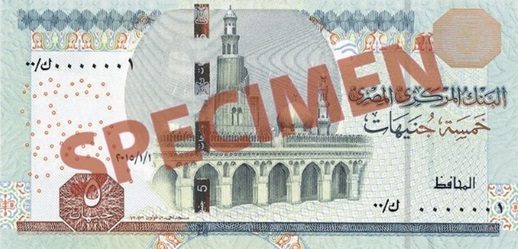
On the reverse is a representation of the god Happi, associated with the flooding Nile. The name Hep comes from the predynastic period of Egypt.
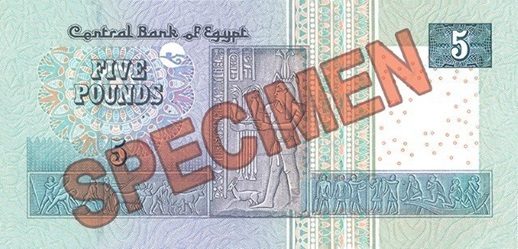
10 Egyptian pounds banknote
The 10 pound note (10 EGP) is informally known in Egypt as the bariza. Its measurements are 132 x 69 cm and its equivalent value in euros at the exchange rate is about 29 euro cents.
The current series was issued in 2022 and is illustrated on the front with a drawing of the Al Fattah Al Alim mosque (2018) located in the new administrative capital.

On the reverse appears an effigy of the statue of Queen Hatshepsut, queen sometime between years 2 and 7 of the reign of her stepson and nephew, Thutmose III. She adopted the full title of a pharaoh, including the throne name Maatkare, which is the name most frequently found on the monuments of her.

20 Egyptian pounds banknote
The 20 pound note (20 EGP) measures 137 x 69 mm, dates from 2023 and is green. Its exchange value is 58 euro cents.
On the obverse you can see the Mehmet Ali Pasha Mosque (Alabaster Mosque or Muhammad Ali). The mosque dates back to the first half of the 19th century and was built at the behest of the Ottoman governor Mehmet Ali. It is quite visible from any point in Cairo due to its high minarets and because it is built in the upper part of the Cairo Citadel.

On the reverse there is a representation of the statue of Queen Cleopatra in profile next to an Egyptian warrior in a chariot with arrows.

50 Egyptian pounds banknote
The 50 Egyptian pounds (50 EGP) banknote measures 160 x 70 mm and is reddish brown. This note, issued in 2015, has a value at the current exchange rate of about 1.46 euros.
The Abu Huraiba mosque is shown on the obverse.

On the reverse we see a beautiful image of the Temple of Edfu dedicated to Horus, next to a traditional felucca, one of the classic boats that travel the Nile. The Temple takes its name from the western bank of the Nile city of Edfu. In Greco-Roman times Edfu was known as Apolinópolis Magna.

100 Egyptian pounds banknote
The 100 EGP banknote (2015 edition) measures 165 x 70 mm and is purple. It has an approximate equivalent value (October 2023) of about 2.91 euros.
On the obverse we see the mosque-madrasa of Sultan Hassan located in the center of Cairo, close to the citadel. Its construction dates back to 1336 and ended in 1363.
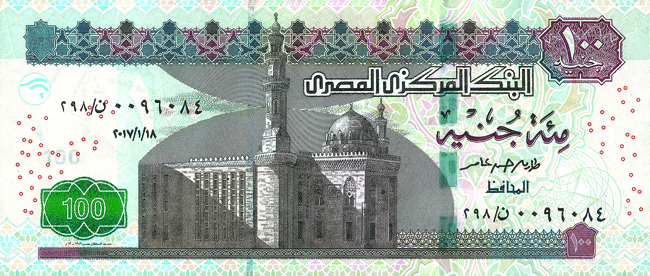
The reverse depicts the Great Sphinx of Giza located about 20 km southwest of Cairo, on the west bank of the Nile River, in the city of Giza. It measures about 20 meters high by 70 meters long and its construction dates back to the 26th century BC.

200 Egyptian pounds banknote
To date, the Egyptian pound banknote with the highest value is the 200 EGP banknote. It was issued in 2015, measures 165 x 73 mm and is in ocher tones. Its equivalent value in euros is about 5.82 euros at the exchange rate in France, November 2023.
On the obverse appears the Great Mosque of Qani-Bay, one of the largest in Cairo, originally from 1503.

On the back we find a reproduction of the “Seated Scribe”, one of the most representative sculptures of Ancient Egypt, nearly 4,500 years old.
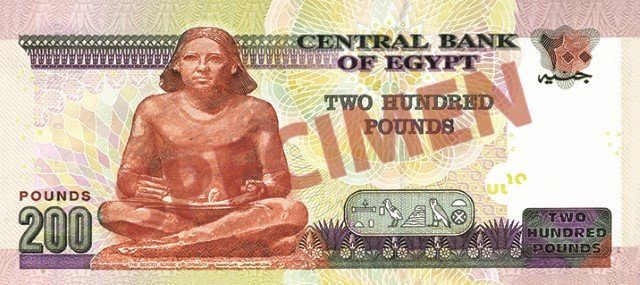
Euro to Egyptian pound exchange rate
The exchange rate of the euro against the Egyptian pound has experienced strong fluctuations in recent years, mainly due to the country’s political instability and the consequent impact on its economy.
If you search on Google for “euro to Egyptian pound exchange rate” you will find dozens of websites like Oanda (“currency converters”) that offer a “rate” of the day. You will also see this graph with the rates of that pair of currencies from Google Finance.
Something like this (November 7, 2023):
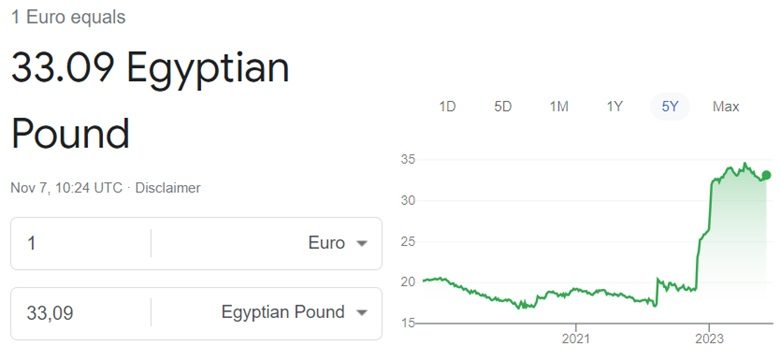
As you can see, the exchange rate in the last months of 2022 has suffered a large depreciation due to the unstable economic situation in the country, going from 20 pounds per euro to almost 35 pounds per euro.
But it must be taken into account that this graph represents the value of the Egyptian pound “currency” against the euro, and not that of the real currency (paper banknotes), which is lower.
In fact, in currency suppliers in France (they are called “bureaux de change”) you can buy Egyptian pounds as of the date of this update (November 7, 2023) at an exchange rate of around 26.95 EGP pounds for every euro that Comparer Devise gives you or 22 .51 pounds that they will give you at the main French airports today (Global Exchange supplier). Nothing to do with the euro to Egyptian pound currency exchange rate, which today is 33.09 pounds per euro.
So, when you see these values on Google and other currency converters with your mobile, you should keep the following in mind:
-This is an unofficial rate, and therefore, not reliable. That is, if you click on the “Disclaimer” link, you get this warning from Google Finance: “Google cannot guarantee the accuracy of the exchange rates displayed. Please confirm current rates before conducting a transaction that may be affected by changes in exchange rates.”
-These rates that you see are usually wholesale prices of the Egyptian pound currency against the euro currency (currency and banknotes of that currency are not the same).
-These rates can only be had between banks, that is, it is impossible to obtain it as an individual. That is why it is also known as the interbank exchange rate.
If you need Egyptian pounds in banknotes you will have to go through the retail banknote market (bank or currency supplier). This means that the Egyptian pounds have had to be “transported” by someone for you to enjoy them (or purchased from travelers from Egypt, passing through France previously).
Moving banknotes from one place to another has logistical costs that will make their sale price (the exchange rate that whoever sells it to you apply) increase. And there is also the exchange rate risk (fear of the currency suppliers that have stock of this currency that it will suffer a significant depreciation).
The Egyptian pound is not a very abundant currency/currency in France. In fact, few currency suppliers sell it. As a result of its scarcity, its price is more expensive in France than in Egypt.
If you decide to buy Egyptian pounds in France, it is good to anticipate the purchase and order them online to obtain a better rate.
Where to exchange Egyptian pounds
The three most popular places to exchange Egyptian pounds in France are banks, currency suppliers and currency suppliers at the airport.
Of them, the least advisable place to buy are airports because they share a lucrative business with the manager who owns the business, which puts millions of travelers at their disposal to do business, in exchange for sharing income. And as you can imagine, a business to be distributed among more participants necessarily requires charging travelers more.
The rates of the two Paris airports that buy or sell pounds are the worst. The currency suppliers located there (Global Exchange) announce that they do not charge commissions, but be careful, because their commercial margins are very high, and therefore their purchase or sale rates are very uninteresting for you.
As for French banks, none of the large ones sell or buy Egyptian pounds. And if they did, they would charge you a commission of 2.5 to 3% on your exchange, in addition to their exchange rate (where they already make a commercial margin). That is to say, if you approach them with 1000 euros, they will keep 30 euros and they will apply their change for the day to only 970 euros.
Therefore, our recommendation is to avoid any business that charges you a commission in addition to an “exchange margin” (difference between the price for which you paid the currency and the price for which it is sold to you) or that advertises “No Commission “, but then you key it with the exchange rate applied.
The best thing is that you try, every day, to see the rates and commissions of your bank with those of the suppliers that collaborate with Comparer Devise. None of them charge commissions and they also have smaller structures to maintain so they can offer you much better rates.
Euro to Egyptian pound exchange rate today
To know the euro-Egyptian pound exchange rate, the best thing you can do is use our currency comparator.
- Exchange euros for Egyptian pounds (EUR-EGP)
- Exchange Egyptian Pounds for Euros (EGP-EUR)

1 Comentarios
One Reply to “Egyptian pound (EGP)”
Merci à l'auteur pour cet article très bien documenté sur la livre égyptienne et les taux de change actuels entre l'euro et le dollar. J'ai appris beaucoup de choses en le lisant et je suis heureux d'avoir une référence si complète pour mes futurs voyages en Égypte.